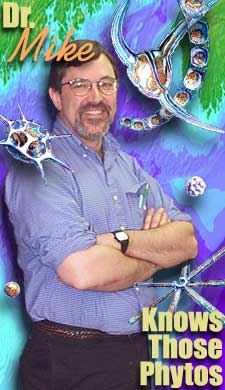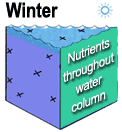


 |
Spring brings increased sunlight
and calmer winds that stir the nutrient-rich waters. Cool ocean
temperatures favor phyto growth over that of their zooplankton grazers.
This is a "window of opportunity" for reproduction of
fast-growers: "weed species" such
as chain diatoms and Phaeocystis.
|
|
When rapid phyto growth exhausts
nutrients, grazers deplete the phyto population. Other
phytos sink and move carbon to deep waters & the seafloor. Bacterial
decomposition of these "sunken phytos" helps recycle nutrients
into the ecosystem.
|
|
|
The traditional view is that phytos
cannot grow until ocean mixing decreases and layering begins, after
formation of the thermocline (see
diagram at left, <<<). Do our Gulf of Maine spring data
support this theory? Investigate the spring bloom by clicking
here.
|
|
 |
As spring becomes summer, sunlight
is readily available for phyto growth but nutrients are scarce in
the upper ocean. The community shifts from fast-growing diatoms
to slow-growing "recyclers," including dinoflagellates (e.g.,
Ceratium)
and ciliates such as Laboea.
|
 |
|
During autumn, decreased sunlight
and increased cooling at the surface increase the density at the
sea surface; this favors sinking of upper waters. Autumn storms
can increase mixing, as well (find out for yourself by clicking
here). Eventually the thermocline breaks downs and favors wind-stirring
of nutrients toward the surface.
|
|
|
|
In general, species such as chain diatoms predominate in early colonization of a habitat. With their high reproductive rates, these "weed species" can quickly take over a disturbed system. On the other hand, some species -- including many dinoflagellates -- prevail as more and more species attempt to colonize a habitat. They have slower growth and reproductive rates, long life spans, but can outcompete other species in late, mature stages of succession. |
 |
|
Think of the wintertime cooling and mixing as the "disturbed" system that gets colonized as the water stratifies in spring. After nutrients are depleted, the mature stages of succession occur with lots of nutrient recycling. This view of the relationship between physical conditions and phytos is shown just above. According to our Gulf of Maine data, do certain types of phytos thrive better under layered conditions? How about mixed conditions? Does species diversity of change seasonally? |